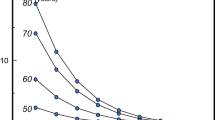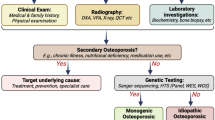Abstract
Osteoporosis prevention is an important public health goal. Bone turnover markers are clinically measured to assess bone strength. C-terminal telopeptide of type I collagen (CTX) is released when collagens degrade and serves as an indicator of bone resorption. Simple CTX immunoassays are now available. However, serum CTX (sCTX) reference ranges for Japanese women are lacking. Procollagen type I N-propeptide (intact P1NP) reflects osteoblast activity, serving as a marker of bone formation. Because sCTX and intact P1NP are clinically applied as bone turnover markers, we determined reference ranges for both sCTX and intact P1NP in healthy Japanese women. We collected 228 blood samples from healthy Japanese women aged 19–83 years, grouped by age and menopausal status. We measured sCTX and intact P1NP and examined their correlation. sCTX values differed significantly between the two consecutive decade groups encompassing 19–39 years of age, intact P1NP values between 20 and 30 s, between post-menopausal 50 and 60 s, and between pre-and post-menopausal women in their 50 s. The mean sCTX of 91 healthy pre-menopausal women was 0.255 (0.100–0.653) ng/mL, the intact P1NP in 90 women 33.2 (17.1–64.7) μg/L. Corresponding values for post-menopausal women were 0.345 (0.115–1.030) ng/mL and 41.6 (21.9–79.1) μg/L. sCTX correlated with intact P1NP. Bone resorption markers are measured to assess anti-resorption agents, bone formation markers to assess the effects of bone-forming agents. The sCTX and intact P1NP reference values determined herein, in healthy Japanese women, are expected to be useful for osteoporosis treatment, assessment of fracture risk, and other clinical applications.





Similar content being viewed by others
References
Orimo H, Yaegashi Y, Onoda T, Fukushima Y, Hosoi T, Sakata K (2009) Hip fracture incidence in Japan: estimates of new patients in 2007 and 20-year trends. Arch Osteoporos 4:71–77
Sakamoto K, Nakamura T, Hagino H, Endo N, Mori S, Muto Y, Harada A, Nakano T, Yamamoto S, Kushida K, Tomita K, Yoshimura M, Yamamoto H (2006) Report on the Japanese Orthopaedic Association’s 3-year project observing hip fractures at fixed-point hospitals. J Orthop Sci 11:127–134
National Institutes of Health (2000) Osteoporosis prevention, diagnosis, and therapy. NIH Consens Statement 17:1–45
Bonde M, Qvist P, Fledelius C, Riis BJ, Christiansen C (1995) Applications of an enzyme immunoassay for a new marker of bone resorption (Cross Laps): follow-up on hormone replacement therapy and osteoporosis risk assessment. J Clin Endocrinol Metab 80:864–868
Fledelius C, Johnsen AH, Cloos PA, Bonde M, Qvist P (1997) Characterization of urinary degradation products derived from type I collagen. J Biol Chem 272:9755–9763
Kyd PA, De Vooght K, Kerkhoff F, Thomas E, Fairney A (1999) Clinical usefulness of biochemical resorption markers in osteoporosis. Ann Clin Biochem 36:483–491
Garnero P, Delmas PD (2003) An immunoassay for type I collagen alpha 1 helicoidal peptide 620–633, a new marker of bone resorption in osteoporosis. Bone 32:20–26
Kawana K, Takahashi M, Hoshino H, Kushida K (2002) Comparison of serum and urinary C-terminal telopeptide of type I collagen in aging, menopause and osteoporosis. Clin Chim Acta 316:109–115
Stein GS, Lian JB (1993) Molecular mechanisms mediating proliferation/differentiation interrelationships during progressive development of the osteoblast phenotype. Endocr Rev 14:424–442
Melkko J, Kauppila S, Niemi S, Risteli L, Haukipuro K, Jukkola A, Risteli J (1996) Immunoassay for intact amino-terminal propeptide of human type I procollagen. Clin Chem 42:947–954
Nishizawa Y, Nakamura T, Ohata H, Kushida K, Gorai I, Shiraki M, Fukunaga M, Hosoi T, Miki T, Nakatsuka K, Miura M; Committee on the Guidelines for the Use of Biochemical Markers of Bone Turnover in Osteoporosis: Japan Osteoporosis Society (2001) Guidelines on the use of biochemical markers of bone turnover in osteoporosis (2001). J Bone Miner Metab 19:338–344
CLSI (2008) Defining, Establishing, and Verifying Reference Intervals in the Clinical Laboratory; Approved Guideline-Third Edition. CLSI document C28-A3. Clinical and Laboratory Standards Institute, Wayne
Nishizawa Y, Nakamura T, Ohta H, Kushida K, Gorai I, Shiraki M, Fukunaga M, Hosoi T, Miki T, Chaki O, Ichimura S, Nakatsuka K, Miura M; Committee on the Guidelines for the Use of Biochemical Markers of Bone Turnover in Osteoporosis Japan Osteoporosis Society (2005) Guidelines for the use of biochemical markers of bone turnover in osteoporosis (2004). J Bone Miner Metab 23:97–104
Clowes JA, Hannon RA, Yap TS, Hoyle NR, Blumsohn A, Eastell R (2002) Effect of feeding on bone turnover markers and its impact on biological variability of measurements. Bone 30:886–890
Zaidi M, Turner CH, Canalis E, Pacifici R, Sun L, Iqbal J, Guo XE, Silverman S, Epstein S, Rosen CJ (2009) Bone loss or lost bone: rationale and recommendations for the diagnosis and treatment of early postmenopausal bone loss. Curr Osteoporos Rep 7:118–126
Zebaze RM, Ghasem-Zadeh A, Bohte A, Iuliano-Burns S, Mirams M, Price RI, Mackie EJ, Seeman E (2010) Intracortical remodelling and porosity in the distal radius and post-mortem femurs of women: a cross-sectional study. Lancet 375:1729–1736
Ivaska KK, Gerdhem P, Akesson K, Garnero P, Obrant KJ (2007) Effect of fracture on bone turnover markers: a longitudinal study comparing marker levels before and after injury in 113 elderly women. J Bone Miner Res 22:1155–1164
Clark P, Cons-Molina F, Deleze M, Ragi S, Haddock L, Zanchetta JR, Jaller JJ, Palermo L, Talavera JO, Messina DO, Morales-Torres J, Salmeron J, Navarrete A, Suarez E, Pérez CM, Cummings SR (2009) The prevalence of radiographic vertebral fractures in Latin American countries: the Latin American Vertebral Osteoporosis Study (LAVOS). Osteoporos Int 20:275–282
Boonyanurak P, Wilawan K (2009) Levels of biochemical bone marker procollagen type 1 N-propeptide (P1NP) in Thai women aged 40–70 years. J Med Assoc Thai 92:873–877
Ardawi MS, Maimani AA, Bahksh TA, Rouzi AA, Qari MH, Raddadi RM (2010) Reference intervals of biochemical bone turnover markers for Saudi Arabian women: a cross-sectional study. Bone 47:804–814
Moayyeri A, Besson H, Luben RN, Wareham NJ, Khaw KT (2010) The association between physical activity in different domains of life and risk of osteoporotic fractures. Bone 47:693–700
Vasikaran S, Eastell R, Bruyere O, Foldes AJ, Garnero P, Griesmacher A, McClung M, Morris HA, Silverman S, Trenti T, Wahl DA, Cooper C, Kanis JA, IOF-IFCC Bone Marker Standards Working Group (2011) Markers of bone turnover for the prediction of fracture risk and monitoring of osteoporosis treatment: a need for international reference standards. Osteoporosis Int 22:391–420
Whipple TJ, Le BH, Demers LM, Chinchilli VM, Petit MA, Sharkey N, Williams NI (2004) Acute effects of moderate intensity resistance exercise on bone cell activity. Int J Sports Med 25:496–501
Maïmoun L, Sultan C (2011) Effects of physical activity on bone remodeling. Metabolism 60:373–388
Yoshimura N, Muraki S, Oka H, Kawaguchi H, Nakamura K, Arune T (2011) Changes in serum levels of biochemical markers of bone turnover during 10 years among Japanese men and women: associated factors and birth-cohort effect. The Taiji Study. JBMM 29:699–708
Moayyeri A (2008) The association between physical activity and osteoporotic fractures: a review of the evidence and implications for future research. Ann Epidemiol 18:827–835
Law MR, Hackshaw AK (1997) A meta-analysis of cigarette smoking, bone mineral density and risk of hip fracture: recognition of a major effect. BMJ 315:841–846
Hoidrup S, Gronbaek M, Gottschau A, Lauritzen JB, Schroll M (1999) Alcohol intake, beverage preference, and risk of hip fracture in men and women. Copenhagen Centre for Prospective Population Studies. Am J Epidemiol 149:993–1001
Huang Y, Eapen E, Steele S, Grey V (2011) Establishment of reference intervals for bone markers in children and adolescents. Clin Biochem 44:771–778
Chaki O, Yoshikata I, Kikuchi R, Nakayama M, Uchiyama Y, Hirahara F, Gorai I (2000) The predictive value of biochemical markers of bone turnover for bone mineral density in postmenopausal Japanese women. J Bone Miner Res 15:1537–1544
Conflict of interest
All authors have no conflicts of interest.
Author information
Authors and Affiliations
Corresponding author
About this article
Cite this article
Nomura, Y., Yoshizaki, A., Yoshikata, H. et al. Study of the distribution by age group of serum cross-linked C-terminal telopeptide of type I collagen and procollagen type I N-propeptide in healthy Japanese women to establish reference values. J Bone Miner Metab 31, 644–651 (2013). https://doi.org/10.1007/s00774-013-0460-y
Received:
Accepted:
Published:
Issue Date:
DOI: https://doi.org/10.1007/s00774-013-0460-y




